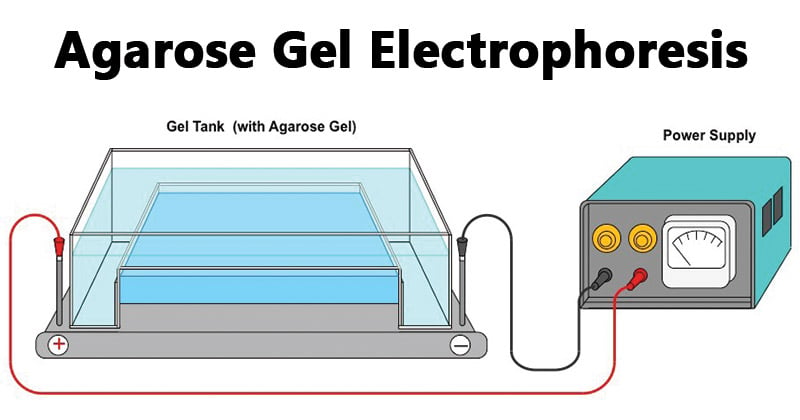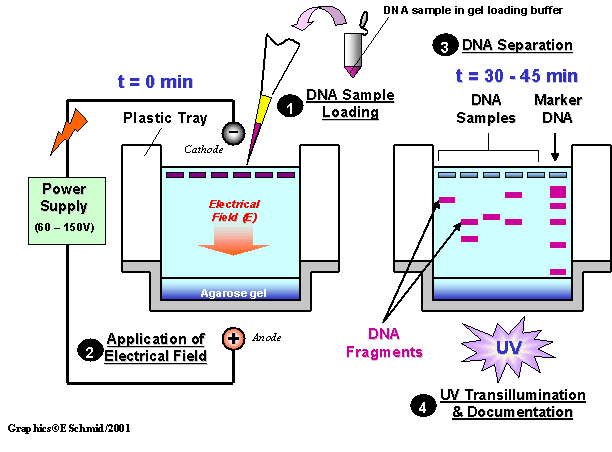Agarose gel electrophoresis is a method of gel electrophoresis used in biochemistry, molecular biology, genetics, and clinical chemistry to separate a mixed population of macromolecules such as DNA , RNA or proteins in a matrix of agarose.
- Agarose is a natural linear polymer extracted from seaweed that forms a gel matrix by hydrogen-bonding when heated in a buffer and allowed to cool.
- They are the most popular medium for the separation of moderate and large-sized nucleic acids and have a wide range of separation.

Interesting Science Videos
Principle of Agarose Gel Electrophoresis
Gel electrophoresis separates DNA fragments by size in a solid support medium such as an agarose gel. Sample (DNA) are pipetted into the sample wells, followed by the application of an electric current which causes the negatively-charged DNA to migrate (electrophorese) towards the anodal, positive (+ve) end. The rate of migration is proportional to size: smaller fragments move more quickly and wind up at the bottom of the gel.
DNA is visualized by including in the gel an intercalating dye, ethidium bromide. DNA fragments take up the dye as they migrate through the gel. Illumination with ultraviolet light causes the intercalated dye to fluoresce.
The larger fragments fluoresce more intensely. Although each of the fragments of a single class of molecule is present in equimolar proportions, the smaller fragments include less mass of DNA, take up less dye, and therefore fluoresce less intensely. A “ladder” set of DNA fragments of known size can be run simultaneously and used to estimate the sizes of the other unknown fragments.
Requirements/ Instrumentation of Agarose Gel Electrophoresis
The equipment and supplies necessary for conducting agarose gel electrophoresis are relatively simple and include:
- An electrophoresis chamber and power supply
- Gel casting trays, which are available in a variety of sizes and composed of UVtransparent plastic. The open ends of the trays are closed with tape while the gel is being cast, then removed prior to electrophoresis.
- Sample combs, around which molten medium is poured to form sample wells in the gel.
- Electrophoresis buffer, usually Tris-acetate-EDTA (TAE) or Tris-borate-EDTA (TBE).
- Loading buffer, which contains something dense (e.g. glycerol) to allow the sample to “fall” into the sample wells, and one or two tracking dyes, which migrate in the gel and allow visual monitoring or how far the electrophoresis has proceeded.
- Staining: DNA molecules are easily visualized under an ultraviolet lamp when electrphoresed in the presence of the extrinsic fluor ethidium bromide. Alternatively, nucleic acids can be stained after electrophoretic separation by soaking the gel in a solution of ethidium bromide. When intercalated into doublestranded DNA, fluorescence of this molecule increases greatly. It is also possible to detect DNA with the extrinsic fluor 1-anilino 8-naphthalene sulphonate.
- Transilluminator (an ultraviolet light box), which is used to visualize stained DNA in gels.
Steps Involved in Agarose Gel Electrophoresis

- To prepare gel, agarose powder is mixed with electrophoresis buffer to the desired concentration, and heated in a microwave oven to melt it.
The concentration of Agarose Gel
- The percentage of agarose used depends on the size of fragments to be resolved.
- The concentration of agarose is referred to as a percentage of agarose to volume of buffer (w/v), and agarose gels are normally in the range of 0.2% to 3%.
- The lower the concentration of agarose, the faster the DNA fragments migrate.
- In general, if the aim is to separate large DNA fragments, a low concentration of agarose should be used, and if the aim is to separate small DNA fragments, a high concentration of agarose is recommended.
- Ethidium bromide is added to the gel (final concentration 0.5 ug/ml) to facilitate visualization of DNA after electrophoresis.
- After cooling the solution to about 60oC, it is poured into a casting tray containing a sample comb and allowed to solidify at room temperature.
- After the gel has solidified, the comb is removed, taking care not to rip the bottom of the wells.
- The gel, still in plastic tray, is inserted horizontally into the electrophoresis chamber and is covered with buffer.
- Samples containing DNA mixed with loading buffer are then pipetted into the sample wells, the lid and power leads are placed on the apparatus, and a current is applied.
- The current flow can be confirmed by observing bubbles coming off the electrodes.
- DNA will migrate towards the positive electrode, which is usually colored red, in view of its negative charge.
- The distance DNA has migrated in the gel can be judged by visually monitoring migration of the tracking dyes like bromophenol blue and xylene cyanol dyes.
Agarose Gel Electrophoresis Video Animation
Applications of Agarose Gel Electrophoresis
Agarose gel electrophoresis is a routinely used method for separating proteins, DNA or RNA.
- Estimation of the size of DNA molecules
- Analysis of PCR products, e.g. in molecular genetic diagnosis or genetic fingerprinting
- Separation of restricted genomic DNA prior to Southern analysis, or of RNA prior to Northern analysis.
- The agarose gel electrophoresis is widely employed to estimate the size of DNA fragments after digesting with restriction enzymes, e.g. in restriction mapping of cloned DNA.
- Agarose gel electrophoresis is commonly used to resolve circular DNA with different supercoiling topology, and to resolve fragments that differ due to DNA synthesis.
- In addition to providing an excellent medium for fragment size analyses, agarose gels allow purification of DNA fragments. Since purification of DNA fragments size separated in an agarose gel is necessary for a number molecular techniques such as cloning, it is vital to be able to purify fragments of interest from the gel.
Advantages of Agarose Gel Electrophoresis
- For most applications, only a single-component agarose is needed and no polymerization catalysts are required. Therefore, agarose gels are simple and rapid to prepare.
- The gel is easily poured, does not denature the samples.
- The samples can also be recovered.
Disadvantages of Agarose Gel Electrophoresis
- Gels can melt during electrophoresis.
- The buffer can become exhausted.
- Different forms of genetic material may run in unpredictable forms.
References
- https://pdfs.semanticscholar.org/36cf/d4ada922c44d233b6ebfa2af2c956c92e4ec.pdf
- https://www.mun.ca/biology/scarr/Gel_Electrophoresis.html
- https://www.wou.edu/las/physci/ch462/Gel%20Electrophoresis.pdf
- https://en.wikipedia.org/wiki/Agarose_gel_electrophoresis
- https://msu.edu/course/css/451/Lecture/PT-electrophoresis%20(2009).pdf
- http://library.umac.mo/ebooks/b28050459.pdf


understood most of it, althought the concept is little difficult but i saw video and read the full notes many times, it helped….. ThANK YOU
Satisfactory… Thanks uh a lot 😊
Very informative and easy to understand.
Informative notes in easy language 👍
Thank You for the Notes.. It’s very informative notes which have coverd allmost all the important things of AGE.
But I have a small doubt regarding the lines in “Principle Part”
Since DNA is negatively charged (anion) and it moves to Anode (+ve charged) end, not the Cathodal end, you mentioned in the paragraph of “Principle of Agarose Gel Electrophoresis”.
Please correct me if I am wrong.
Hi Mahesh,
Thanks for the correction. I have updated the post with an anodal, positive (+ve) end.
Best,
Sagar
very informative notes and accurate easy to understand..keep doing like this..
This helped out in more clarification! Just had a lecture on electrophoresis today,with this I comprehend more on it.
Thank you for this!